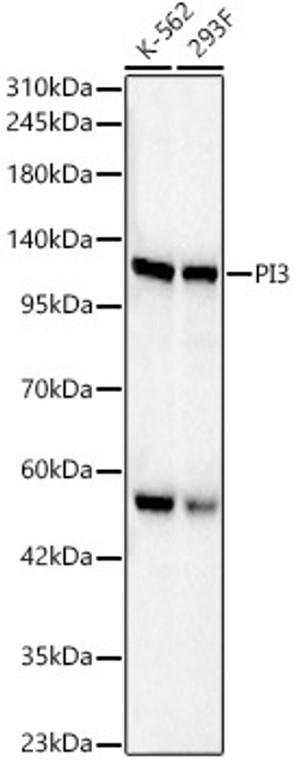| Host: |
Rabbit |
| Applications: |
WB |
| Reactivity: |
Human/Rat |
| Note: |
STRICTLY FOR FURTHER SCIENTIFIC RESEARCH USE ONLY (RUO). MUST NOT TO BE USED IN DIAGNOSTIC OR THERAPEUTIC APPLICATIONS. |
| Short Description: |
Rabbit polyclonal antibody anti-PI3 Kinase p110 beta (410-600) is suitable for use in Western Blot research applications. |
| Clonality: |
Polyclonal |
| Conjugation: |
Unconjugated |
| Isotype: |
IgG |
| Formulation: |
PBS with 0.02% Sodium Azide, 50% Glycerol, pH7.3. |
| Purification: |
Affinity purification |
| Dilution Range: |
WB 1:1000-1:5000 |
| Storage Instruction: |
Store at-20°C for up to 1 year from the date of receipt, and avoid repeat freeze-thaw cycles. |
| Gene Symbol: |
PIK3CB |
| Gene ID: |
5291 |
| Uniprot ID: |
PK3CB_HUMAN |
| Immunogen Region: |
410-600 |
| Immunogen: |
Recombinant fusion protein containing a sequence corresponding to amino acids 410-600 of human PI3 Kinase p110 beta (NP_006210.1). |
| Immunogen Sequence: |
KVKTKKSTKTINPSKYQTIR KAGKVHYPVAWVNTMVFDFK GQLRTGDIILHSWSSFPDEL EEMLNPMGTVQTNPYTENAT ALHVKFPENKKQPYYYPPFD KIIEKAAEIASSDSANVSSR GGKKFLPVLKEILDRDPLSQ LCENEMDLIWTLRQDCREIF PQSLPKLLLSIKWNKLEDVA QLQALLQIWPK |
| Tissue Specificity | Expressed ubiquitously. |
| Post Translational Modifications | Autophosphorylation at Ser-1070 negatively regulates the phosphatidylinositol-4,5-bisphosphate 3-kinase activity. |
| Function | Phosphoinositide-3-kinase (PI3K) phosphorylates phosphatidylinositol derivatives at position 3 of the inositol ring to produce 3-phosphoinositides. Uses ATP and PtdIns(4,5)P2 (phosphatidylinositol 4,5-bisphosphate) to generate phosphatidylinositol 3,4,5-trisphosphate (PIP3). PIP3 plays a key role by recruiting PH domain-containing proteins to the membrane, including AKT1 and PDPK1, activating signaling cascades involved in cell growth, survival, proliferation, motility and morphology. Involved in the activation of AKT1 upon stimulation by G-protein coupled receptors (GPCRs) ligands such as CXCL12, sphingosine 1-phosphate, and lysophosphatidic acid. May also act downstream receptor tyrosine kinases. Required in different signaling pathways for stable platelet adhesion and aggregation. Plays a role in platelet activation signaling triggered by GPCRs, alpha-IIb/beta-3 integrins (ITGA2B/ ITGB3) and ITAM (immunoreceptor tyrosine-based activation motif)-bearing receptors such as GP6. Regulates the strength of adhesion of ITGA2B/ ITGB3 activated receptors necessary for the cellular transmission of contractile forces. Required for platelet aggregation induced by F2 (thrombin) and thromboxane A2 (TXA2). Has a role in cell survival. May have a role in cell migration. Involved in the early stage of autophagosome formation. Modulates the intracellular level of PtdIns3P (phosphatidylinositol 3-phosphate) and activates PIK3C3 kinase activity. May act as a scaffold, independently of its lipid kinase activity to positively regulate autophagy. May have a role in insulin signaling as scaffolding protein in which the lipid kinase activity is not required. May have a kinase-independent function in regulating cell proliferation and in clathrin-mediated endocytosis. Mediator of oncogenic signal in cell lines lacking PTEN. The lipid kinase activity is necessary for its role in oncogenic transformation. Required for the growth of ERBB2 and RAS driven tumors. Has also a protein kinase activity showing autophosphorylation. |
| Protein Name | Phosphatidylinositol 4 -5-Bisphosphate 3-Kinase Catalytic Subunit Beta IsoformPi3-Kinase Subunit BetaPi3k-BetaPi3kbetaPtdins-3-Kinase Subunit BetaPhosphatidylinositol 4 -5-Bisphosphate 3-Kinase 110 Kda Catalytic Subunit BetaPtdins-3-Kinase Subunit P110-BetaP110betaSerine/Threonine Protein Kinase Pik3cb |
| Database Links | Reactome: R-HSA-109704Reactome: R-HSA-112399Reactome: R-HSA-114604Reactome: R-HSA-1257604Reactome: R-HSA-1660499Reactome: R-HSA-186763Reactome: R-HSA-198203Reactome: R-HSA-201556Reactome: R-HSA-202424Reactome: R-HSA-2029485Reactome: R-HSA-210993Reactome: R-HSA-2219530Reactome: R-HSA-2424491Reactome: R-HSA-2730905Reactome: R-HSA-373753Reactome: R-HSA-4420097Reactome: R-HSA-512988Reactome: R-HSA-5673001Reactome: R-HSA-6811558Reactome: R-HSA-8853659Reactome: R-HSA-9027276Reactome: R-HSA-912526Reactome: R-HSA-912631Reactome: R-HSA-9673767Reactome: R-HSA-9673770Reactome: R-HSA-9680350 |
| Cellular Localisation | CytoplasmNucleusInteraction With Pik3r2 Is Required For Nuclear Localization And Export |
| Alternative Antibody Names | Anti-Phosphatidylinositol 4 -5-Bisphosphate 3-Kinase Catalytic Subunit Beta Isoform antibodyAnti-Pi3-Kinase Subunit Beta antibodyAnti-Pi3k-Beta antibodyAnti-Pi3kbeta antibodyAnti-Ptdins-3-Kinase Subunit Beta antibodyAnti-Phosphatidylinositol 4 -5-Bisphosphate 3-Kinase 110 Kda Catalytic Subunit Beta antibodyAnti-Ptdins-3-Kinase Subunit P110-Beta antibodyAnti-P110beta antibodyAnti-Serine/Threonine Protein Kinase Pik3cb antibodyAnti-PIK3CB antibodyAnti-PIK3C1 antibody |
Information sourced from Uniprot.org
12 months for antibodies. 6 months for ELISA Kits. Please see website T&Cs for further guidance






